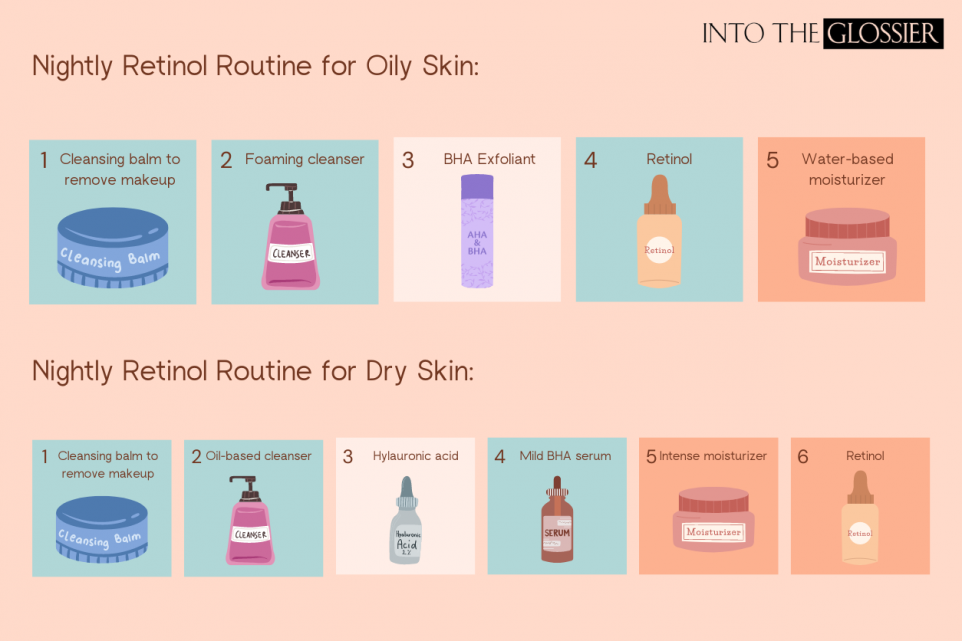Should You Use Retinol Before or After Moisturizing? Let’s Settle the Debate!

Retinol is arguably one of the most popular skincare products, known for its transformative power to tackle signs of aging and fighting breakouts. But there are some things to consider when adding it to your nightly skincare routine.
First things first, let’s talk about what retinol actually is. It’s a type of retinoid, derived from vitamin A, widely acclaimed for its ability to renew and improve the appearance of skin. Regular use of retinol has been shown to promote skin renewal, brighten skin tone, reduce acne, and minimize the appearance of fine lines and wrinkles. It works by increasing collagen production and accelerating cell turnover. This makes it a go-to ingredient for those looking to revitalize their skin.
Choosing the Right Retinol for Oily and Acne-Prone Skin
If your skin tends to be oily, you might be primarily concerned with breakouts and clogged pores. In this case, look for a retinol product that’s formulated specifically for acne-prone skin. These formulations are usually lighter, absorb quickly, and don’t leave a greasy residue. A retinol serum with a concentration of about 0.3% to 0.5% is a good starting point. It’s effective yet gentle enough to prevent excessive irritation.
Choosing the Right Retinol for Dry and Sensitive Skin
Dry skin types should pick retinol products that are delivered in a cream base, which helps to counteract the potentially drying effects of retinol. Start with a lower concentration, such as 0.1% to 0.3%, to allow your skin to adjust without overwhelming it. Products that combine retinol with hydrating ingredients like hyaluronic acid or ceramides can also be particularly beneficial, as they help to maintain the skin’s moisture barrier.
Choosing the Right Retinol for Mature Skin
If aging and sun damage are your main concerns, you might want to look for a high-performance retinol. Concentrations can range up to 1% or higher in these products. These higher doses are more potent in reversing signs of aging such as deep wrinkles and sunspots. However, it’s crucial to build up your skin’s tolerance gradually to avoid irritation.
Incorporating Retinol into Your Skincare Routine
Incorporating retinol into your skincare routine should be done gradually. Start by applying a pea-sized amount of retinol cream or serum to your face a couple of times a week, and slowly increase the frequency as your skin builds tolerance. This helps to minimize the common side effects of retinol, such as dryness and peeling.
For Oily Skin, Use Retinol BEFORE Moisturizing
Managing skincare for oily skin can be challenging due to the complexity of balancing oil production while ensuring the skin remains healthy and clear. Here’s an effective evening routine designed specifically for oily skin:
Start with a Cleansing Balm: Start your routine by melting away the day’s makeup and grime with a cleansing balm. It’s gentle yet effective, ensuring you start with a clean slate without stripping your skin.
Follow Up with a Double Cleanse: Even if it’s the end of the day, make sure any residual sunscreen, makeup or dirt is gone. A foaming cleanser with salicylic acid gets deep into your pores to give your skin a thorough cleanse so you have a clear canvas for the next steps.
Apply a BHA Exfoliant: Why BHA for oily skin, you ask? BHA, or beta-hydroxy acid, is oil-soluble, which means it can penetrate deeper into the pores to remove excess sebum and dead skin cells, incredible for those prone to acne and oiliness.
Time for Retinol: Opt for a retinol formula that suits your skin’s tolerance level. If you’re a beginner, start with a lower concentration, around 0.25% to 0.5%. Retinol can be quite potent, so starting low and slow is the key to letting your skin adapt without causing irritation.
Finish with a Water-Based Moisturizer: After retinol, lock in hydration with a lightweight, water-based moisturizer. It hydrates your skin without adding extra oiliness.
For Dry Skin, Use Retinol AFTER Moisturizing
If you’ve got dry skin, your skincare routine should prioritize maintaining and enhancing the skin barrier function, ensuring adequate hydration and minimizing irritation:
Begin with a Cleansing Balm: Like with oily skin, start by dissolving makeup and built-up dirt with a cleansing balm. It’s effective yet gentle, preserving your skin’s natural oils.
Double Cleanse with a Hydrating Gel-Based Cleanser: After the first round of cleansing, follow up with a gel-based cleanser to fully cleanse your face without drying out your skin.
Apply Hyaluronic Acid: Before your skin dries, apply a hyaluronic acid serum to damp skin. Hyaluronic acid is fantastic for dry skin as it pulls moisture from the air into your skin, plumping and moisturizing deeply.
Use an AHA Serum: AHAs are excellent for dry skin because they are water-soluble and help exfoliate the surface without the harshness that can aggravate dryness. Opt for a serum with lactic acid (a type of AHA known for its gentle touch) at about 5% to 10% concentration. Serums are preferable for dry skin as they are designed to deliver active ingredients to exfoliate deeply and gently.
Layer on a Rich Moisturizer: Choose a moisturizer rich in occlusives and emollients like shea butter or ceramides. These ingredients help to lock in moisture and repair your skin barrier, creating the perfect base for retinol.
Finally, Apply Retinol: Now that your skin is well-hydrated and protected, apply a pea-sized amount of retinol. Doing so after moisturizing can help reduce the potential irritation retinol might cause on dry skin, making it more tolerable and effective.
Listening to Your Skin
Your skin’s response is the ultimate guide in adjusting your retinol usage. If you notice excessive dryness, redness, or peeling, it may be wise to reduce the frequency of application. Conversely, if your skin is tolerating the retinol well without adverse effects, you might consider gradually increasing the concentration or frequency to maximize benefits.
